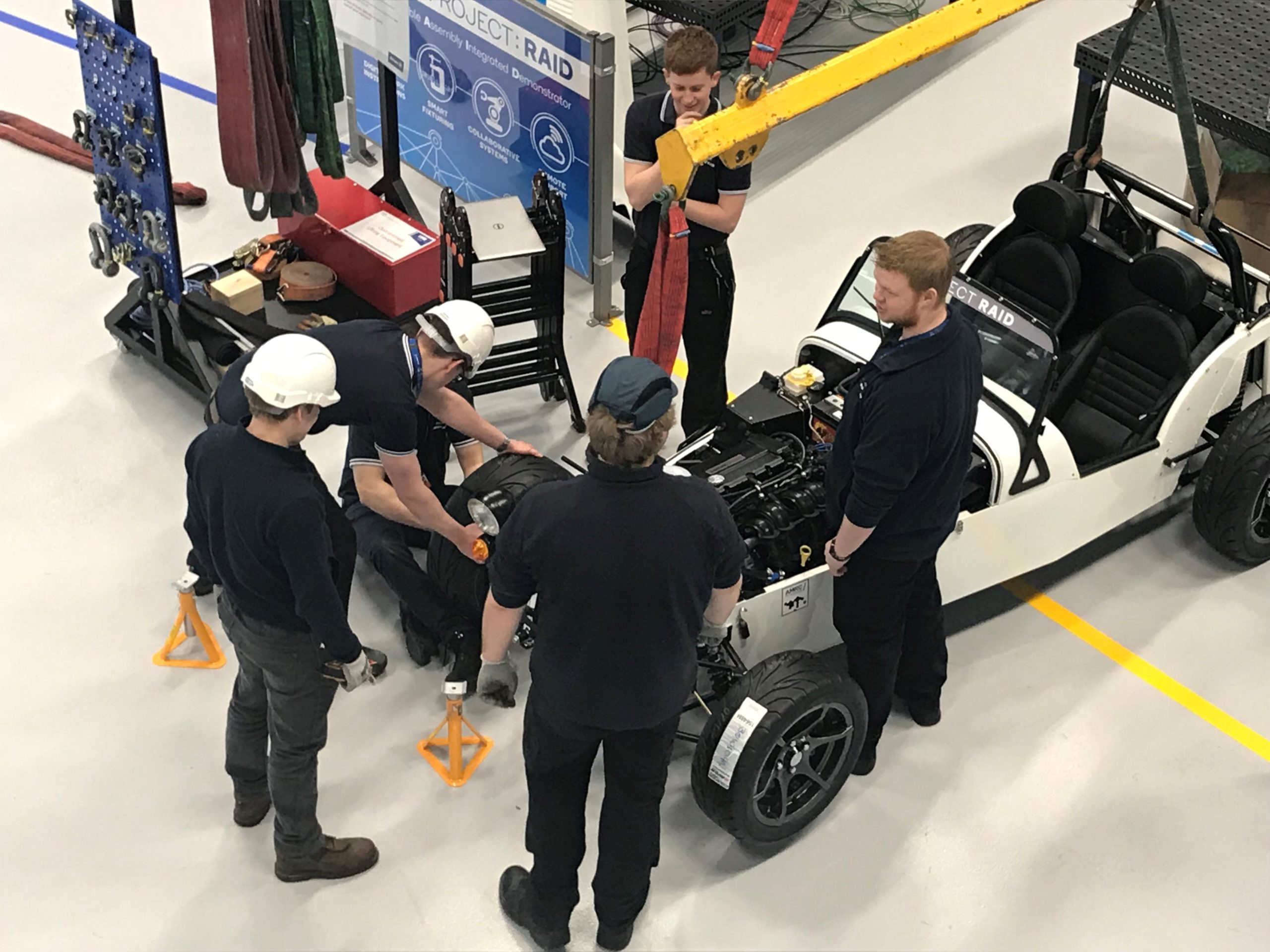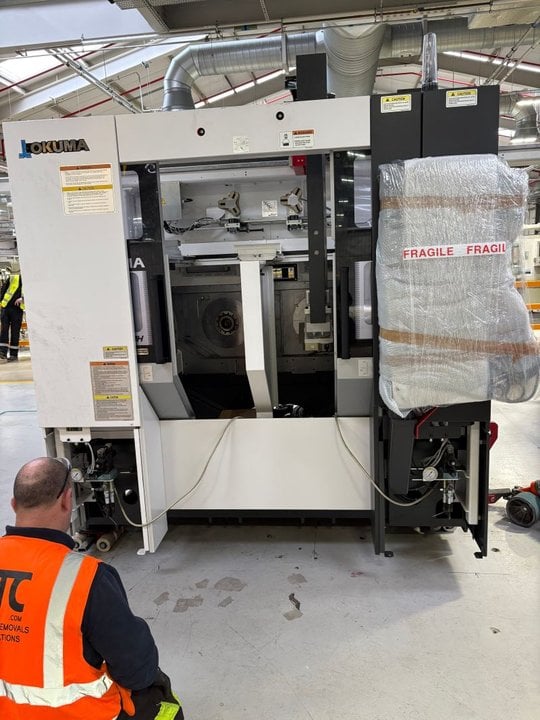
From moon shot to sling shot

For all his many failings as Prime Minister, Boris Johnson was an optimist with a bold vision for the future of Britain. He imagined a ‘science superpower’ and an ‘innovation nation’, with ‘moon shot’ research putting thruster rockets under economic growth to ‘level up’ a lopsided economy where London is racing ahead while the rest of the country chugs behind. John Yates explores the legacy of Booster Boris and its implications for advanced manufacturing.
 When Boris Johnson stood in front of Stephenson’s Rocket in Manchester in the summer of 2018 he was just six months away from a famous election victory. He used the occasion to rehearse the key themes of his upcoming campaign: at its core was a belief that ‘turbocharging’ the nation’s strengths in science, technology and innovation would help level up and unite a deeply divided country.
When Boris Johnson stood in front of Stephenson’s Rocket in Manchester in the summer of 2018 he was just six months away from a famous election victory. He used the occasion to rehearse the key themes of his upcoming campaign: at its core was a belief that ‘turbocharging’ the nation’s strengths in science, technology and innovation would help level up and unite a deeply divided country.
He heralded a ‘moon shot’ Britain that would lead the world in the design and development of automated vehicles, electric cars, buses, planes and satellites, all “made possible by technologies being developed now in the UK. If we unite our country, with better education, better infrastructure, with an emphasis on new technology, then this really can be a new golden age for the UK.”
How different the landscape looks today.
Four years, and two Tory Prime Ministers later, the Conservative Party seems destined to become a museum piece like Stephenson’s Rocket. Dig deeper, however, and elements of Johnson’s vision could yet survive the chaotic events of the last three months, with the Tories creating a new Department for Science Innovation and Technology (DSIT) and Labour nailing its colours to an industrial strategy and a renewed passion for science which runs from Harold Wilson’s ‘white heat of technology’ to Lord Mandelson’s ‘new industries, new jobs’.
Until the recent shakeup, however, Johnson’s science and innovation legacy has attracted little media attention, largely because it is the result of behind-the-scenes capability building by Sir Patrick Vallance, the Government Chief Scientific Adviser, a figure invisible to the public eye in normal times but brought into the spotlight by his daily Covid briefings alongside Chief Medical Officer, Chris Whitty.
At the apex of this capability sits the National Science and Technology Council (NSTC) – established by Johnson and Vallance last year only to be scrapped by Liz Truss during her 15 minutes of fame and then reinstated by Rishi Sunak. It is now a Cabinet-level body led by the Prime Minister comprising growth and skills related government departments including Education and the Treasury to drive a joined-up approach to delivery. This is serviced by the cross-departmental Office for Science and Technology Strategy (OSTS), whose mission is to put science and technology at the centre of government business.
In addition, an independent Council for Science and Technology, drawn from leading figures in industry and research will directly advise the Prime Minister on how to harness science and technology to become an innovation nation. Such industry voices will be vital if the big breakthrough ‘moon shot’ discoveries are to be translated into technologies that will drive big improvements in productivity and growth.
But who will deliver this? Universities were left out of DSIT and stayed instead within the Department for Education which some feel is a potential recipe for confusion. Professor John Krebs, commenting on the publication of the recent House of Lords Science and Technology Committee report, warned the new structures could make the UK more of a ‘bureaucratic superpower’ than a science superpower.
Even if higher education had been placed in the new DSIT, many wonder whether the current university R&D system is up to the task of delivering either the deep transformative science of moon shots or the applied R&D technologies that diffuse innovations across the economy.
While former Science Minister, Lord Willetts, recognises that universities are one of our greatest national assets, he says: “Having them so dominant distorts our national R&D because of the distinctive incentive structure for university academics – the emphasis on academic publication as the crucial measure of performance. It is one reason for our poor performance in applying research and using it to grow big new companies.”
To challenge this model at the deep end of R&D, the government has set up the Advanced Innovation Research Agency (ARIA). Modelled on America’s defence-related DARPA, it will “hand freedom and control to a small number of the highest-calibre researchers, from public and private spheres,” to spend £800m on transformative projects free from traditional higher education bureaucracy. It is a bold and potentially disruptive vision.
But is there an equally bold and disruptive vision for the applied end of the R&D rocket booster? Not yet.
Currently, the UK has a haphazard patchwork quilt of Catapult centres across the country, including the High Value Manufacturing Catapult (HVM Catapult) which works with industries in many of the sectors covered by the MTDCNC team including automotive, aerospace, defence, oil and gas and nuclear.
The Catapult idea was inspired by the success of the well-funded, purpose-built Fraunhofer facilities in Germany, all of which are independent of the country’s university system.
Instead of following the German model, however, the then Coalition government leveraged the UK’s existing place-based industrial innovation assets to establish the seven-member HVM Catapult, five of which are ultimately owned and governed by universities. Old wine in new bottles. 
This was a mistake. The success and longevity of the Fraunhofer network comes from it being independent of academia, government and industry. This, along with the scale of its funding, gives it the convening power to pull together high-performing teams drawn from R&D institutions across the country or internationally, and to pull in people from industry to grind down difficult-to-solve technological and innovation challenges.
Lord Willetts identified this threat to the Catapults’ independence, mission and longevity in his paper, The Road to 2.4%, where he highlighted the case of the University of Sheffield AMRC, which, ironically, had been a role model for the establishment of the HVM Catapult.
“A new Vice Chancellor comes in and isn’t interested in the same thing as their predecessor. Applied research institutes linked to universities, such as the excellent Advanced Manufacturing Research Centre linked to the University of Sheffield do not, therefore, enjoy the long-term stability of a Fraunhofer Institute in Germany. And whilst universities want these research institutes to boost their research rankings, they don’t necessarily survive in the long run, in a university environment,” Willetts wrote.
When Keith Ridgway, along with the other founders of the AMRC, quit three years ago, he wrote in the Yorkshire Post that the Catapults should have been made independent of universities to avoid any potential friction between institutions with often very different cultures, behaviours, missions and interests.
The independence principle briefly gained traction when Dominic Cummings was trying to rewire the government’s approach to science and technology from his roost in Number 10, but it became a casualty of the pandemic and an ill-fated trip to Barnard Castle. Some still believe that the HVM Catapult and the wider network, are essential to a more diverse UK research infrastructure. Perhaps. But not as currently constituted. 
First government must free the HVM Catapult from university ownership and governance, as Willetts and Cummings intimated. Following this, the seven centres should be unshackled from one another, while the costly and ineffective central management function in Solihull is scrapped: a significant saving in itself.
The next step would be to lift the bonnet and understand what the HVM Catapults are actually doing. Despite being set up as translational research agencies – ‘pulling cutting-edge research from the UK’s world-leading universities into the commercial market’– this has rarely been their core business.
Unlike the Fraunhofer network, the HVM Catapult Annual Report has no details of the number of patents, spinouts, shareholdings and trademarks it has created. The Fraunhofer, by contrast, headlines shareholdings in 84 firms, the creation of 50 new start-ups and the filing of 521 patent applications; two patents per working day.
Today’s HVM Catapult is not a translational research network, which is a gap still be to be filled. Instead, its mission is the adaptation, diffusion and adoption of existing smart technologies by industry. Its facilities are shining showrooms for tech vendors like Dassault Systemes and America’s PCT.
Alongside this, it is playing a growing role in skills development by exploiting its close relationship with the industry to deliver high-quality apprentice-training programmes that will inspire the next generation of engineers.
This opens up the possibility of a very different, but very valuable role, for the HVM Catapult in tackling two of the most challenging problems facing the economy: kick-starting productivity and ensuring any new growth is shared fairly in a way that overcomes the huge regional inequalities in performance and prosperity.
Rather than focusing on sectors, technologies and missions, would it not be better to pivot the HVM Catapult to a place-based R&D function that identifies, nurtures and grows local and regional innovation capabilities, technology absorptive capacity, and human skills and talent development?
This change is hinted at in a brilliant short paper submitted to the soon-to-be-published Nurse review on the UK’s R&D and innovation infrastructure by Eoin O’Sullivan and Richard Jones. The authors note: “The missing elements in the UK landscape of RD&I institutions are regional institutes with a specific mandate to enhance and fill gaps in regional innovation capabilities. This places the UK at a disadvantage in supporting the high-value industry clusters across the country that are crucial for productivity growth and reducing regional inequality.”
The authors hint that this could be carried out by ‘institutions that are part of, or allied to, the Catapult network’ which they envisage being connected ‘more closely with local and regional economic governance’ financed and supported through a series of ‘innovation deals.’
In a similar vein, in a paper submitted by Professor Keith Ridgway at the request of Michael Gove’s office and forwarded to the Nurse review, we argued that a repurposed and restructured Catapult network, especially the HVM Catapult, could be the platform for a regional network of innovation assets across its existing footprint in the South West, Wales, the Midlands, the North West, the North East, Yorkshire and Scotland.

Our paper went a step further than Jones and O’Sullivan in suggesting the repurposed Catapults be brought under the wing of devolved Mayoralties and beefed-up Local Enterprise Partnerships with senior industry expertise. This model would be aligned with the DSIT’s work in mapping the UK’s emerging innovation clusters.
By pooling the complex and divisive multi-billion pound funding competitions into a single pot would equip devolved city regions with the tools to accelerate growth. It would also give Parliament a clear line of sight as to where and how public money is being spent; and to measure how well it delivers national ‘levelling up’ and ‘innovation nation’ objectives, providing democratic accountability missing from the current R&D infrastructure.
These well-financed, independent R&D and innovation institutions, operating alongside elected city Mayors would also strengthen the leverage elected political leaders could exert on regional anchor institutions which are better funded than regional councils and sometimes resistant to playing a regional economic growth role.
This power to convene could also be a valuable asset in cities where local stakeholders tend to be siloed, or worse, hostile to one another. The devolved arrangement also creates clear lines of accountability and a direct link to regional electorates who will have a stake in shaping their local economic policies.
At the launch of its ‘Parks and Innovation’ report into the success of Ridgway’s AMRC, the Centre for Cities Director Andrew Carter made a telling observation that applied research innovation centres like the AMRC is often viewed from London as regional assets, and by their home regions as national assets. As a result, they tend to be ignored and unloved by both, falling through the policy and funding gaps. Our approach, which aligns national and regional, would mean we no longer need to mind the gap.















